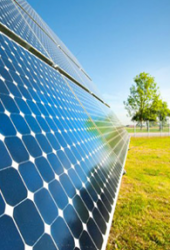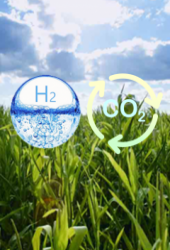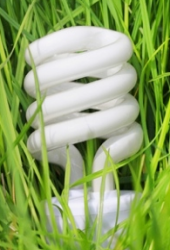Detail:
- บทคัดย่อ
งานวิจัยฉบับนี้เป็นส่วนหนึ่งของวิทยานิพนธ์ เรื่อง การพัฒนาโคมไฟประหยัดพลังงานซึ่งใช้เทคนิคการให้แสงเฉพาะที่เพื่อเสริมการให้แสงในบริเวณทั่วไปสำหรับอาคารสำนักงาน โดยมีวัตถุประสงค์เพื่อเปรียบเทียบประสิทธิภาพพลังงานและประสิทธิภาพแสงสว่างระหว่างเทคนิคการให้แสงเฉพาะที่เพื่อเสริมการให้แสงในบริเวณทั่วไป และเทคนิคการให้แสงสว่างในพื้นที่ใช้งานในลักษณะทั่วไป โดยใช้วิธีการจำลองสภาพเสมือนจริงของการให้แสงสว่างในพื้นที่อาคารสำนักงานด้วยโปรแกรมคอมพิวเตอร์ DIALux 4.6 ในขั้นตอนการวิจัยได้จำลองห้องทำงาน ขนาด 27 ตารางเมตร จำนวนสองห้อง ห้องทำงานแรกใช้เทคนิคการให้แสงสว่างในพื้นที่ใช้งานในลักษณะทั่วไป และห้องทำงานที่สองใช้เทคนิคการให้แสงเฉพาะที่เพื่อเสริมการให้แสงในบริเวณทั่วไป โดยกำหนดให้ค่าเฉลี่ยของค่าการส่องสว่างที่ระนาบแนวนอนที่ระดับโต๊ะทำงานของทั้งสองห้องมีค่าเท่ากัน
ผลการวิจัยพบว่า ค่ากำลังไฟฟ้าส่องสว่างภายในของห้องทำงานที่ใช้เทคนิคการให้แสงเฉพาะที่เพื่อเสริมการให้แสงในบริเวณทั่วไป มีค่า 7.11 วัตต์/ตารางเมตร ส่วนห้องทำงานที่ใช้เทคนิคการให้แสงสว่างในพื้นที่ใช้งานในลักษณะทั่วไป มีค่า 13.33 วัตต์/ตารางเมตร โดยผลที่ได้นั้นมีค่าน้อยกว่าค่ากำลังไฟฟ้าส่องสว่างภายในสำหรับอาคารสำนักงานที่มีค่า 14 วัตต์/ตารางเมตร ซึ่งกำหนดโดยร่างกฎกระทรวงฯ พ.ศ.2550 เมื่อเปรียบเทียบระหว่างสองเทคนิคพบว่า ห้องทำงานที่ใช้เทคนิคการให้แสงเฉพาะที่เพื่อเสริมการให้แสงในบริเวณทั่วไปมีค่ากำลังไฟฟ้าส่องสว่างภายในที่น้อยกว่าห้องทำงานที่ใช้เทคนิคการให้แสงสว่างในพื้นที่ใช้งานในลักษณะทั่วไป 46.7% เมื่อนำเทคนิคนี้ไปประยุกต์ใช้งานในพื้นที่อาคารสำนักงานทั่วไปจะสามารถช่วยลดการใช้พลังงานไฟฟ้าที่ใช้สำหรับระบบแสงสว่างลงได้ และสามารถนำไปใช้เป็นเกณฑ์ในการพัฒนาออกแบบอุปกรณ์ทางด้านการให้แสงสว่างต่อไปได้ในอนาคต
คำสำคัญ : เทคนิคการให้แสงเฉพาะที่เพื่อเสริมการให้แสงในบริเวณทั่วไป, ค่ากำลังไฟฟ้าส่องสว่างภายใน, อาคารสำนักงาน, ประสิทธิภาพพลังงาน, ประสิทธิภาพแสงสว่าง - บทคัดย่อ
งานวิจัยนี้เป็นการวิจัยเชิงทดลอง (experimental research) ศึกษาตัวแปรมวลสารผนังภายนอก (thermal mass) และทิศทางอาคาร (orientation) ซึ่งเป็นปัจจัยสำคัญในการลดปริมาณการถ่ายเทความร้อน และสภาวะน่าสบายในอาคารพักอาศัยในภูมิอากาศร้อนชื้น การวิจัยทำการทดลอง ณ อำเภอหาดใหญ่จังหวัดสงขลา ตั้งอยู่ที่ละติจูด 6055N และลองติจูด100026E ทำการทดลองในเดือนเมษายน – กรกฎาคม พ.ศ.2553 โดยกำหนดค่าสัมประสิทธิ์การถ่ายเทความร้อนของมวลสารผนังภายนอกเป็นตัวแปรควบคุม ศึกษาประสิทธิภาพมวลสารผนังภายนอก 3 ชนิด คือ (1) ผนังมวลสารน้อยใช้วัสดุคอนกรีตมวลเบา (2) ผนังมวลสารปานกลางใช้วัสดุก่ออิฐมอญฉาบปูนครึ่งแผ่นติดฉนวนโฟมหนา 0.11 ซม. และ (3) ผนังมวลสารมากใช้วัสดุอิฐมอญฉาบปูนเต็มแผ่นติดฉนวนโฟมหนา 0.05 ซม. ในการศึกษาทำการก่อสร้างห้องทดลองอุณหภูมิระบบปิดขนาด 1.20X2.40X2.40 ม. จำนวน 3 ห้อง มาตราส่วน 1:1 เพื่อเก็บข้อมูลอุณหภูมิอากาศภายในและภายนอกตลอด 48 ชั่วโมง ทั้ง 8 ทิศ รูปแบบการทดลองทั้งหมด 24 กรณี โดยใช้อุปกรณ์วิทยาศาสตร์บันทึกข้อมูลด้านอุณหภูมิ การวิเคราะห์ประสิทธิผลใช้กระบวนการพิจารณาจากผลต่างขององศาชั่วโมงของอุณหภูมิสะสม (degree hour) ฐาน 18oC ผลการวิจัยโดยการเปรียบเทียบตัวแปรมวลสารผนังภายนอกพบว่า ตลอด 24 ชั่วโมง และช่วงเวลากลางคืนผนังมวลสารน้อยมีประสิทธิภาพสูงสุดในการลดอุณหภูมิอากาศและเกิดสภาวะน่าสบายสูงสุด แต่ในช่วงเวลากลางวันผนังมวลสารมากกลับมีประสิทธิภาพสูงสุดในการลดอุณหภูมิอากาศและเกิดสภาวะน่าสบายมากที่สุด และเมื่อเปรียบเทียบอิทธิพลของทิศทางอาคารในช่วงเวลากลางวันพบว่าทิศตะวันตกเฉียงใต้รับอิทธิพลจากรังสีแสงอาทิตย์น้อยที่สุดส่งผลให้เพิ่มประสิทธิภาพมวลสารผนังภายนอกในการลดพฤติกรรมการถ่ายเทความร้อนและเกิดสภาวะน่าสบายสูงสุด
คำสำคัญ : - บทคัดย่อ
งานวิจัยนี้จึงมีเป้าหมายเพื่อพัฒนาแนวคิดการนำแสงธรรมชาติเข้ามาทดแทนแสงประดิษฐ์ในอาคารด้วยการนำแผงสะท้อนแสงเหนือระนาบทำงานภายในอาคาร( interior daylighting panels )มาใช้เสริมกับหิ้งสะท้อนแสง(lightshelves) เพื่อให้แสงจากช่องเปิดด้านข้าง ตกลงบนระนาบทำงานเพิ่มขึ้น และเสริมประสิทธิภาพการเพิ่มความส่องสว่างในอาคารของหิ้งสะท้อนแสง โดยการศึกษากำหนดขอบเขตเป็นอาคารสำนักงาน ที่ตั้งในเขตละติจูด 14 องศาเหนือ และมีช่วงเวลาใช้งาน 8.00 -16.00 น. ทำการศึกษาตัวแปรที่เกี่ยวข้องกับประสิทธิภาพของแผงสะท้อนแสงเหนือระนาบทำงานทั้งตัวแปรกายภาพด้านรูปแบบ พื้นผิววัสดุ ระดับติดตั้ง และตัวแปรที่ช่วยส่งเสริมประสิทธิภาพด้านรูปทรงของหิ้งสะท้อนแสงที่ช่องเปิดอาคาร รวมทั้งหมด 120 การทดลอง ประเมินผลโดยใช้หุ่นจำลองในการวัดค่าเดย์ไลท์ แฟคเตอร์(daylight factor) ที่เพิ่มขึ้นและระยะที่ความส่องสว่างผ่านเกณฑ์ 2 %DF จากช่องเปิดทิศเหนือ-ใต้ แล้วนำผลมาคำนวณกับข้อมูลปริมาณแสงกระจายจากท้องฟ้าเฉลี่ยรายชั่วโมงของทุกเดือน เพื่อหาความส่องสว่างจากแสงธรรมชาติที่ได้และแสงประดิษฐ์ที่ต้องการเพิ่มมาเปรียบเทียบประสิทธิภาพในการประหยัดพลังงาน ผลการศึกษา พบว่าแผงสะท้อนแสงเหนือระนาบทำงานที่มีประสิทธิภาพมากที่สุดทางด้านกายภาพ คือลักษณะโค้งระนาบนอน พื้นผิวมีการสะท้อนแสงลักษณะกระเจิงแสง (spread reflection) และติดตั้งที่ระดับความสูงประมาณ 2.75 เมตร มีประสิทธิภาพในการเพิ่มระยะจากช่องเปิดที่มีค่าความส่องสว่างเพียงพอจากกรณีปกติ( base case )ที่ใช้ หิ้งสะท้อนแสงแบบเรียบที่ช่องเปิดอย่างเดียวเพิ่มขึ้น 1.70 เมตร หรือ 42.50% ในทิศเหนือ และเพิ่มขึ้น 1.75 เมตร หรือ 53.85% ในทิศใต้ ประหยัดพลังงานเพิ่มขึ้น 34.42 %ต่อปีในทิศเหนือและ 12.40 % ต่อปีในทิศใต้ นอกจากนี้ยังพบอีกว่าหากมีการใช้แผงสะท้อนแสงเหนือระนาบทำงานดังกล่าวนี้ร่วมกับหิ้งสะท้อนแสงโค้งจะสามารถเพิ่มระยะที่แสงสว่างเพียงพอได้อีก 10.53% ในทิศเหนือ และ 16.00%ในทิศใต้ อีกทั้งสามารถประหยัดพลังงานเพิ่มขึ้นได้อีก 17.68 %ต่อปีในทิศเหนือ และ14.13 % ต่อปีในทิศใต้อีกด้วย โดยข้อสรุปที่ได้สามารถนำไปประยุกต์ใช้ในอาคารที่มีการใช้ประโยชน์จากแสงธรรมชาติผ่านช่องเปิดด้านข้างต่อไป
คำสำคัญ : แผงสะท้อนแสงเหนือระนาบทำงาน ,หิ้งสะท้อนแสง - Abstract
Facade greening enhance thermal comfort to indoor and out door environment by reducing heat gain to building, protecting from solar radiation, absorbing solar radiation for Photosynthesis and Evapo-transpiration, reducing radiation and reflection to outdoor environment, reducing temperature outdoor as well as indoor. The more leaf coverage and leaf layers, the better thermal performance and the more energy efficient to all buildings applied.
This research aim to study the use of climbing plants as vertical shading device “Biofacade” for naturally ventilated building, with window facing west. Four experiment were carried out to compare temperature of room with “Biofacade” and room without, adding natural and mechanical ventilation to both rooms and compare the increasing performance.
It was found that “Biofacade” has best performance when wind speed is high from natural ventilation mode, reducing temperature from ambient air to the maximum of 9.93 degree celcius, average of 3.63 degree celcius in the day time (9.00-20.30).When windspeed is low, “Biofacade” has maximum temperature of 6.72, average of 0.91 degree celcius lower than normal room. At night ( 21.00-8.30) “Biofacade” has higher temperature than normal room and ambient air in all cases. By increasing mechanical ventilation with 2 exhaust fans,the nightime difference came down to average of 0.71, 0.2 degree celcius from normal room and from ambient air accordingly. Besides, the higher temperature of ambient air, the better performance in heat gain reduction since leaves maintain surface temperature under 37 degree celcius and always below ambient temperature .From the 4 experiments , the room temperature with “Biofacade” never came down to comfort zone during the day time. The application can be recommnended to use for pre-cooling the air-intake of the air condition system, so it can reduce cooling load efficiently.
Keyword : Facade Greening, Climbing plants, shading device, heat transfer, Building Performance, Energy efficient - Abstract
The energy transform to the mechanical power is established from engine. Recently, the most popular and high efficiency engine is internal combustion engine that transforms chemical energy as petroleum fuel. Now, the worlds know that the internal combustion engine is the main cause of pollution problem and many problems in our environment. From limited energy of petroleum fuel that inspirited to innovate any new prime movers, the energy directly transforms from solar differential energy. One ideal of the other is the energy transform from compressed air engine that uses to storage energy and applies to use in small vehicle. The prototype engine that consists of high pressure state expander and low pressure state expander for increasing thermodynamic efficiency and more mechanical power from single state expansion. Firstly, high pressure air flows to the pressure regulator for pressure throttling that reduces pressure approximately 35- 20 bar, before flows to the system. The system composes two sliding vane expanders; another has five sliding vanes. Volume of high pressure state expander is 12.5 cc and volume of low pressure state expander is 60 cc .the study process is separated into two sections, design and assembly prototype is the first section and experimental section is basic characteristic education. From experimental data, the highest total power is 752 watts when the inlet pressure is 30 bar and ambient temperature of nitrogen to the engine. The total power is the sum of high pressure state expansion giving 252 watts at 1925 rpm, 1.25 N.m in torque and low pressure state expansion giving 500 watts at 1475 rpm, 3.24 N.m in torque. In conclusion, the mechanical efficiency of prototype engine is very low compares to the theoretical isothermal efficiency.
Keyword : high state expander, low state expander, compressed air, engine - Abstract
This research is aimed to compare the performance of the hot water system using flat plate solar collector with the size of 2 m2 and hot water storage of 150 litres with heat pipe solar collector with the size of 1.2 m2 and hot water storage of 86 litres. The system consists of a solar collector, the insulated water storage tank, a circulating pump and the pump controller. The hot water systems are installed on the roof floor of building in Chulalongkorn university. The solar collector is installed at the angle of 15 degrees with a horizontal plane for flat plate and 35 degrees for heat pipe and facing south direction. The operating parameters effecting the system are solar intensity, the initial storage water temperature, the final storage water temperature, the inlet and outlet water temperature of collector, ambient air temperature and wind velocity. The data were collected at the interval of 2 minutes during 8:00 to 16:00 hour basis. The hot water stored energy is calculated by the equation and the efficiency of hot water system by From the experiment, the system efficiency ,η is depend on solar intensity ,I, initial water temperature Ti, final water temperature in the storage tank ,Tf ,and ambient air temperature ,Ta and the quantity of hot water used. For the range of experiment. , when the average solar intensity is 384-602 w/m2 and the initial water temperature is 29 °C,the hot water system efficiency with flat plate solar collector ranges from 39-43 % .The energy is accumulated in the hot water storage ranges from 8.7-14.9 MJ/day and the maximum hot water temperature is 53.1 °C .When the initial water temperature is increased to 50.2 °C, the system efficiency is also decreased to 31.5 % .Also if hot water is used 50 % of its volume during 1 pm., the system efficiency is increased to 57.3 % . While the hot water system efficiency with heat pipe solar collector ranges from 22 – 28 % .The energy is accumulated in the hot water ranges from 3.4 – 5.2 MJ/day and the maximum hot water temperature is 45.4 ° When the initial water temperature is increased to 51 °C, the system efficiency is also decreased to 19.6 % .Also if hot water is used 50 % of its volume during 1 pm., the system efficiency is increased to 37 % The solar collector efficiency at slope 35 o is greater than at slope 55 o and the efficiency is increased 9-13 % by inserting an aluminum foil plate at the back of the collector . Also the final water temperature in the storage tank is increased 3 – 5 °C .In the hot water system of low temperature in this research,the system efficiency using flat plate solar collector is higher than using heat pipe solar collector.
Keywords :Flat Plate, Heat Pipe, Solar Collector, Hot Water - บทคัดย่อ
การเปรียบเทียบการใช้พลังงานและสมรรถนะจากการเปลี่ยน recuperator ที่ใช้กับ reheating furnace การศึกษาเริ่มจากการวัดข้อมูลต่างๆ เพื่อคำนวณสมดุลพลังงานและสมดุลพลังงานของ recuperator และทำสมดุลพลังงานของ reheating furnace ที่ใช้ในกระบวนการผลิตเหล็กเส้นสำหรับงานก่อสร้าง ในการทำงาน 3 ช่วงคือ ช่วงอุ่นเตา ช่วงก่อนเข้าการผลิต และช่วงการผลิตต่อเนื่อง พบว่า recuperator เดิมมีอากาศรั่วภายใน recuperator สูงถึงร้อยละ 14.8 เมื่อเทียบกับอากาศที่เข้าเตาทั้งหมด ค่า effectiveness สูงขึ้นเล็กน้อย การถ่ายเทความร้อนลดลง ค่า overall heat transfer ลดลง การเปลี่ยน recuperator ทำให้อากาศเข้าเตามีอุณหภูมิสูงขึ้น 80.4 oC ในช่วงทำงานปกติ ส่งผลให้การเผาไหม้ภายในเตาดีขึ้นสามารถลดอากาศส่วนเกินลงได้ และลดปริมาณอากาศและปริมาณก๊าซที่ไหลผ่าน recuperator ทำให้มีการประหยัดพลังงานเฉลี่ยร้อยละ 19.8
คำสำคัญ :recuperator, reheating furnace, energy saving, steel, effectiveness - บทคัดย่อ
ในปัจจุบัน การผลิตกระแสไฟฟ้าของโรงไฟฟ้าแม่เมาะกำลังประสบปัญหาการเกิดตะกรันขึ้นในผนังของหม้อไอน้ำของโรงไฟฟ้า ทำให้การถ่ายเทความร้อนระหว่างห้องเผาไหม้ไปยัง Water Tube ของหม้อไอน้ำประสิทธิภาพลดลงทำให้เกิดการสูญเสียกำลังการผลิตไฟฟ้า ซึ่งสาเหตุหลักที่ก่อให้เกิดตะกรันคือ ถ่านหินที่มีปริมาณร้อยละของ CaO อยู่ในช่วง 23-35% จึงได้ทำการทดลองโดยนำตัวอย่างถ่านหินจำนวน 3 ตัวอย่าง ที่มีค่า % CaO แตกต่างกันคือ ตัวอย่าง Q2 (2.24% CaO), ตัวอย่าง Q4 (27.34% CaO) และ ตัวอย่าง K3 (31.81% CaO) และตัวอย่างที่ผสมกันระหว่าง ตัวอย่าง Q2 กับ ตัวอย่าง Q4 โดยนำตัวอย่างทั้งสามมาหาค่าอุณหภูมิเริ่มต้นการหลอม (Initial Deforming Temperature: IT) พบว่าตัวอย่าง Q4 มีค่า IT ต่ำกว่าอุณหภูมิในเตาของหม้อไอน้ำ หลังจากนั้นนำตัวอย่างทั้งหมดมาเผาที่อุณหภูมิ 800 C – 1,200 C แล้วนำมาวิเคราะห์ด้วยวิธี X-Ray Diffraction (XRD) เพื่อหาชนิดของแร่ในแต่ละอุณหภูมิของตัวอย่างพบว่า แร่ในตัวอย่าง Q4 และแร่ในตัวอย่างถ่านหินผสมระหว่าง Q2 20% กับ Q4 80% ที่น่าจะเป็นสาเหตุให้มีค่า IT ต่ำคือ แร่เกห์เลไนต์
คำสำคัญ :Slag, Blended Coal Ash, Ash Fusion, Ternary Phase Diagram - Abstract
This research has the objective to analyze cost structure and investment conditions for Small Power Procedures (SPP) electricity generation. As a result, this paper could be guidance for decision making of interested SPP investors. The research methodology was the following: collecting and studying the secondary data that related to the topic, then considering the criteria for categorized the power generating system. The power generating process and type of fuel-mixed have been chosen. Therefore, several types of grouping SPP, which related to criteria, have been selected as the case studies. Co-generating power which steam is another byproduct of the process is the result of the study. And the research also found that the government should continuously promote the SPP investments policy further in the future. Since the private investment has alleviated the burden of the Government Investment and enhanced the usage of domestic energy efficiently. Furthermore, the research concept would also been applied with the investment of the other type of generation system.
Key words :small power producer, co-generating power generation, Firm contract - Abstract
The purpose of this research is to develop key performance indicators (KPIs) suitable for practicing and reflecting natural gas service quality for retail of the studied company. It also includes the existing controlling and evaluating indices of the studied company to be synchronized with the company’s goals. The research starts with studying and collecting all related KPIs of both studied company and comparable global practices, which leads to the next step to categorize them to four aspects based on EU’s concept; i.e., quality, continuity, reliability, and customer satisfaction. As a result of the benchmarking, the 83 indicators are selected and obtained to derive questionnaire for responding the director’s opinions and refining indicators specialized for each aspect fallen within 2 main criteria, which are consistency of the organization and readiness of the data. The analytic network process (ANP) is then employed to prioritize and support robust multicriteria decision-making, which is compiled by Super Decisions 2.0.8 resulting 28 indicators covering four aspects as stated earlier. These indicators are then expressed the opinions by company’ directors and related sector personnel that finally deliver the most suitable and acceptable 10 KPIs.
Key words :Key Performance Indicators (KPIs), Service Quality, Benchmarking and Analytic Network Process (ANP).
Volume : 8 Issue : 1 Year : 2011





